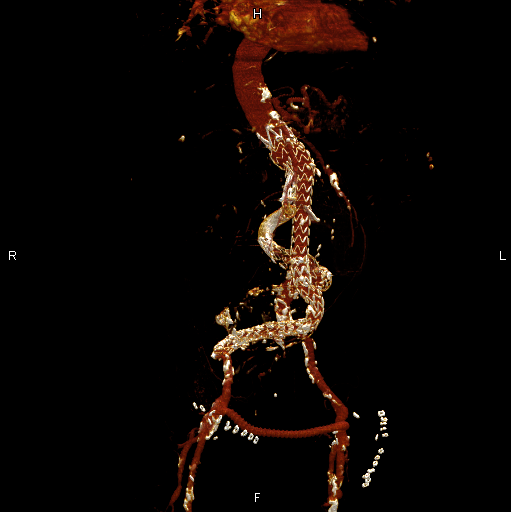Back to Annual Meeting Program
Complex Endovascular Peri-Renal Aortic Aneurysm Repair Preserving Perfusion to a Horseshoe Kidney
Jane K Yang, Lee J. Goldstein, Jorge Rey, Omaida C. Velazquez
University of Miami, Miller School of Medicine, Miami, FL
Background
Improvements in endovascular technology have allowed a larger range of abdominal aortic aneurysms (AAA) to be treated with endovascular approaches, but horseshoe kidneys continue to present challenging anatomy for even open surgical repairs.
Additionally, it has been clearly demonstrated that renal failure after abdominal aneurysm repair increased postoperative mortality. This report describes a case of an elderly man with significant comorbidities and a peri-renal horseshoe kidney whose AAA was successfully treated with a complex endovascular repair to preserve renal function.
Methods
An 83 year old man with a history of severe emphysema and hypertension presented with a symptomatic 7.1 centimeter AAA and acute renal insufficiency. A CT additionally demonstrated a 6.4 cm right iliac artery aneurysm, a 2.6 cm left common femoral artery aneurysm and a horseshoe kidney with his left renal artery origin proximal to the aneurysm neck but a right renal artery supplied from the body of the aneurysm.
Given the severity of his pulmonary disease, risk of embolization of his renal arteries, as well as difficulty of cross-clamping the aorta with the horseshoe kidney, the decision was made to perform an EVAR with preservation of his right renal artery.
The left common femoral artery aneurysm was excised and replaced with a 10 mm dacron graft, and an Endurant (Medtronic, Minneapolis, MN) main body deployed via the left common femoral artery. Both of his iliac arteries were severely tortuous, making cannulation of the contralateral gate extremely difficult, so the gate was cannulated via left brachial access. An occlusion plug was used to occlude the gate and convert the endograft into an aortouniiliac system. The right renal artery was then serially stented with two iCAST (Atrium Medical Corp., Hudson, NH) stents, a Viabahn (Gore Medical, Flagstaff, AZ) stent, and two Endurant limb extensions into the distal common iliac artery. A femoral-femoral bypass was then performed to provide left leg perfusion. 
Results
Completion angiography demonstrated straight-line flow from the aorta to the right iliac limb, across the femoral-femoral bypass with perfusion of the right renal artery via retrograde filling of the left common iliac artery with no evidence of a leak. Follow-up CT at 2 weeks demonstrated filling of the right renal artery and entirety of the horseshoe kidney with no evidence of endoleak. His creatinine remained 0.9 post-operatively.
Conclusions
Patients presenting with both AAA and horseshoe kidneys are rare, reported in the literature as only 0.12% of AAAs. This patient presented with the challenging anatomy of not only a horseshoe kidney, but with a peri-renal AAA. Options included either reimplantation or ligation of the right renal artery, but would have necessitated an open surgery or worsened renal failure in this patient. The complex aneurysm repair chosen demonstrates an alternative method, allowing for preservation of the perfusion and function of his horseshoe kidney.
Back to Annual Meeting Program

